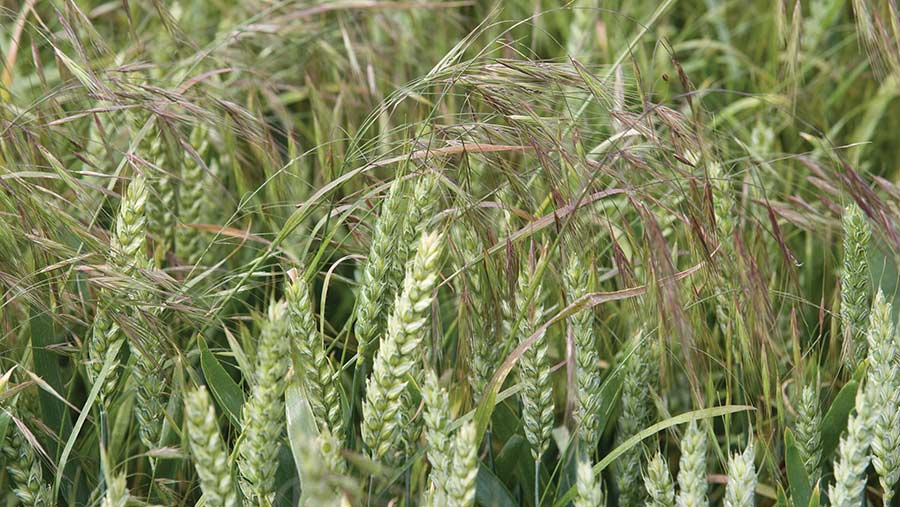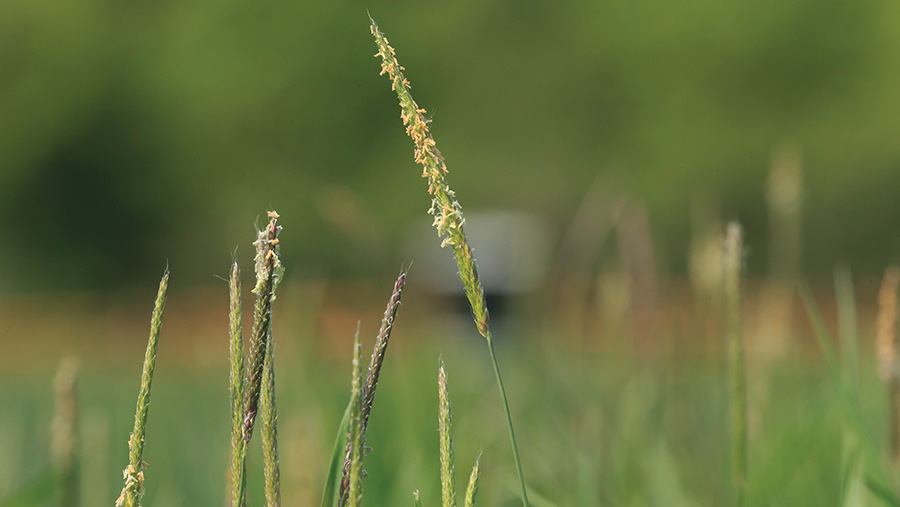Tips on tackling brome caused by blackgrass measures
 © Tim Scrivener
© Tim Scrivener Brome problems arising from blackgrass measures can easily be tackled, providing that farmers know which species they are dealing with.
Both meadow and soft bromes have been an unwanted appearance in Agrii’s blackgrass trials at its Stow Longa site in Cambridgeshire.
The company’s head of agronomy, Colin Lloyd, recalls that by year four of the cultivations and rotations trial, the odd meadow, soft and sterile brome had appeared and more are now being seen, especially in the min-till and direct-drill plots.
See also: Grower improves fungicide use and compaction with helicopter
“There are significant numbers in some plots with up to 95 ears/sq m.”
He explains that seed from both meadow and soft species of brome like to sit on the soil surface to break dormancy.
But to encourage a blackgrass chit, they have been tickling the surface and this burial meant the seed remained dormant, to then emerge later in the crop.
To tackle this brome problem, last summer’s early harvest offered an opportunity to leave seed on the surface a month before scratching it. However, this has led to sterile brome appearing this summer, as they like to be in the dark to break dormancy.
Colin says this shows how changing cultivations can have an effect on the weed profile, and they now have a sterile brome problem.
The good news is that sterile brome is fairly easy to tackle by ploughing, as shown in a separate Agrii trial near Edinburgh a few years ago.
They looked at two different drill dates (2 and 17 October), winter wheat and winter barley grown in either a plough or direct-drill system.
Later drilling reduced brome numbers, while the plough treatment resulted in much lower numbers. In the second year of the trial, they ploughed again and numbers were very low.
“We managed to break the cycle in one year. This certainly wouldn’t happen with blackgrass.”
Put another way, they were only getting 5-20% control for direct-drilled wheat receiving a full herbicide programme. Growing more aggressive hybrid barley saw this rise to 69% control.”
In terms of yield, ploughing gave a 1.68t/ha yield lift with barley and a bigger yield increase of 5.02t/ha was seen in wheat.
“This shows that the cost of a sterile brome problem can be massive, especially in winter wheat.”

© Tim Scrivener
Why was blackgrass so bad in 2022-23?
The lack of a chit in last autumn’s dry conditions and earlier wheat drilling are being blamed for the surge in blackgrass, but Agrii’s head of agronomy, Colin Lloyd, believes the late winter/early spring weather had a bigger effect by hampering crop competition.
Looking at the weather itself, February was dry followed by a very wet March, which was effectively a month lost.
Farmers missed timings with nitrogen fertiliser, which combined with the lower temperatures resulted in slow-growing crops.
Consequently, blackgrass had less competition, allowing it to tiller well and that’s why we saw more ears this summer.
Lack of spring crop competition
Colin points to winter barley, which saw almost three times the expected blackgrass heads, ranging from 90 to 255 ears/sq m.
“Conditions meant it didn’t get going in early spring and didn’t express its hybrid vigour so well.”
There was a large 3t/ha range in winter barley yields (5.51-8.85t/ha). Colin says this contrasts with last year, where it yielded more than 10t/ha regardless of cultivations.
“Again, this indicates it did not get going in spring and did not out-bully the blackgrass. Similarly, direct-drilled wheat was thinner and saw up to 209 blackgrass ears/sq m.
Like the winter crops, spring barley struggled on this site to get going and blackgrass was seen at crop height and above in some plots. In contrast, spring oats were competitive and they didn’t see the weed at crop height or above.
Looking at margins, the average winter wheat cost of agchem inputs was £466.66/ha, which was 20% up on the year before due to higher prices.
This, combined with lower wheat prices, meant for the first time in the trial, wheat has gone negative, with -£405/ha for direct drilling after a cover crop. And there were up to 274 ears/sq m, so a big seed return, too.
With its lower costs, spring malting barley in the plough system gave the highest gross margin of £1,449/ha.
Overall, there was a £1,854 difference in margins across the treatments. “That is a lot of money and shows how important it is to get it right – the wrong decision can cost negative margins.”
Agrii trials manager Steve Corbett says 2023 was the season farmers had to get right.
Looking ahead, he says there are going to be some big seed returns and, for fields with a high population, changes will be needed. Given where prices are, farmers can’t afford not to make changes.
Pre-emergence sequence and stacks – latest results from Agrii trials
While the arrival of cinmethylin and aclonifen has brought more firepower into pre-emergence programmes, cultural control is still a vital part of weed control.
Jodie Littleford, Agrii technical manager for combinable crop trials, says cultural controls help avoid having to “throw the kitchen sink at it”, thereby reducing crop competition and letting weeds in.
She advises front-loading a pre-emergence herbicide programme with the strongest options first, such as Luxinum Plus (cinmethylin) and Orient (pendimethalin + picolinafen).
“Our work indicates that when Luximo Plus is partnered with picolinafen in combination with pendimethalin, it consistently delivers better blackgrass and ryegrass control than mixes containing straight pendimethalin.
“This sets up crops for success, with control topped up if needed, alongside residual and contact follow-ups.”
A programmed approach is also essential for tackling tough ryegrass situations.
For example, a 2021 trial in Yorkshire showed that a Luxinum Plus and Orient mix reduced levels to 30 heads/sq m compared with 247 heads/sq m in the untreated plot.
A peri-emergence follow-up of Octavian Met (diflufenican + flufenacet + metribuzin) plus Pontos (flufenacet + picolinafen) brought this down to 7 heads/sq m.
This can be further reduced with a post-emergence application of Hatra (iodosulfuron + mesosulfuron), but this may sacrifice crop competition.
“Good control is achievable, but at a cost. There is a point where spring cropping is a better approach,” she says.
